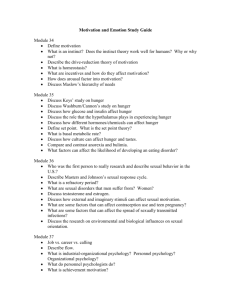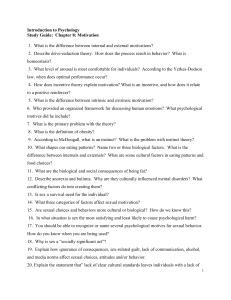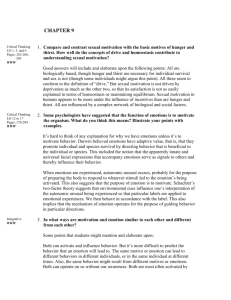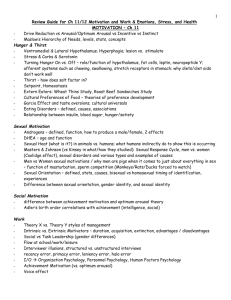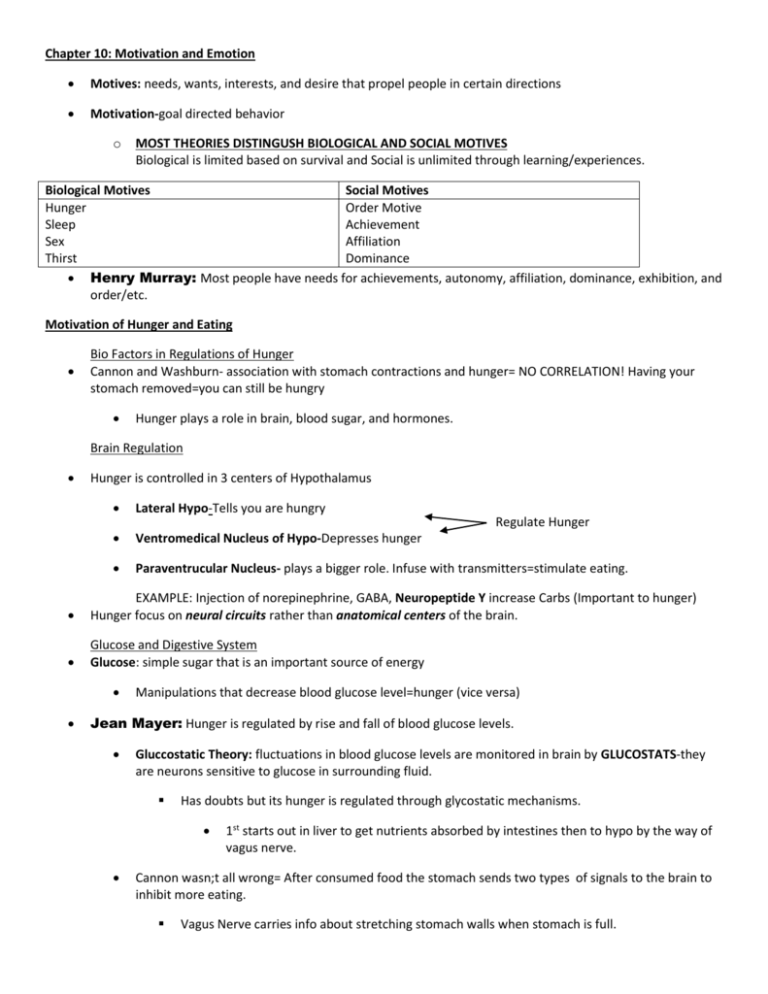
Chapter 10: Motivation and Emotion
Motives: needs, wants, interests, and desire that propel people in certain directions
Motivation-goal directed behavior
o
MOST THEORIES DISTINGUSH BIOLOGICAL AND SOCIAL MOTIVES
Biological is limited based on survival and Social is unlimited through learning/experiences.
Biological Motives
Social Motives
Hunger
Order Motive
Sleep
Achievement
Sex
Affiliation
Thirst
Dominance
Henry Murray: Most people have needs for achievements, autonomy, affiliation, dominance, exhibition, and
order/etc.
Motivation of Hunger and Eating
Bio Factors in Regulations of Hunger
Cannon and Washburn- association with stomach contractions and hunger= NO CORRELATION! Having your
stomach removed=you can still be hungry
Hunger plays a role in brain, blood sugar, and hormones.
Brain Regulation
Hunger is controlled in 3 centers of Hypothalamus
Lateral Hypo-Tells you are hungry
Regulate Hunger
Ventromedical Nucleus of Hypo-Depresses hunger
Paraventrucular Nucleus- plays a bigger role. Infuse with transmitters=stimulate eating.
EXAMPLE: Injection of norepinephrine, GABA, Neuropeptide Y increase Carbs (Important to hunger)
Hunger focus on neural circuits rather than anatomical centers of the brain.
Glucose and Digestive System
Glucose: simple sugar that is an important source of energy
Manipulations that decrease blood glucose level=hunger (vice versa)
Jean Mayer: Hunger is regulated by rise and fall of blood glucose levels.
Gluccostatic Theory: fluctuations in blood glucose levels are monitored in brain by GLUCOSTATS-they
are neurons sensitive to glucose in surrounding fluid.
Has doubts but its hunger is regulated through glycostatic mechanisms.
1st starts out in liver to get nutrients absorbed by intestines then to hypo by the way of
vagus nerve.
Cannon wasn;t all wrong= After consumed food the stomach sends two types of signals to the brain to
inhibit more eating.
Vagus Nerve carries info about stretching stomach walls when stomach is full.
Other nerves sends messages on how rich nutrients in stomach are.
Hormonal Regulation
Insulin- Hormone secreted by pancreas
o
Extracts glucose from blood (more sensitive to where bodies store fat)
o
Injections stimulate hunger also normal secretion of insulin by pancreas
o
Not enough insulin=diabetes
Judith Rodin: Smell of enticing food can stimulate secretion of insulin/hunger.
Leptin is produced by fat cells from the body and release to blood.
o
Increase fat= higher levers of leptin which inhibits eating
o
Leptin release neuropeptide Y =activity in paraven. Nucleus of hypo which causes you not to eat.
o
Page 391
Environmental Factors in regulation of hunger
Learned preferences and habits
People from different cultures display different food consumption
Learning=influence on what we eat
Humans have innate taste preference of general sort
Taste preference by classical conditioning
Eating habits shaped by observation
Repeat exposures=liking of food
Forcing a child to eat= negative effect on child’s preference
Individual reaction to food shaped by others around them
Learned habits and social considerations influence when and how people eat.
Food related cues
Exposure to environmental cure associated with eating
o
EXAMPLE: TV commercials for delicious food or odors from kitchen trigger hunger
Stanley Schachter: how external cues affect hunger/eating behavior to some extent.
o
EXAMPLE: How tasty and how food is appeared, availability and much effort to eat it.
Stress, Arousal, and Eating
Stress leads to increase eating
Stress induce eating is common in women than men and more dieters
o
Stress induced arousal than stress itself stimulates eating
o
Link between arousal and overeating
Eating and Weight: Obesity
Obesity: condition of being overweight
o
People are overweight if exceed 20% of their body weight
o
24% men and 27% women, increasing of obesity
o
More vulnerable to cardio disease, diabetes, hyperextension, respiratory, gallbladder, stroke, arthritis
and back problems.
o
American culture=slimness=stress
Evolutionists believed people abandoned diet by their ancestors which led to this
24% men and 40% women diet
o
More beneficent to people health by exercise and eating right (Still has risks)
o
Page 393
Genetic Predisposition
Body Mass Index- Weight divided by height squarded
o
Measure of weight controls variation of height= BMI increase used in research of obesity.
o
Identical twins have similar BMI than fraternal.
o
61 percent is inherited in men and 73 percent for women
Weight influence by genetic makeup
Vulnerability to obesity is in genetics
The Concept Set Point
People who tend to lose weigbht gain it back later
Set Point- stability in weight
o
Body monitors fat cell levels to keep them stable
o
When fat stores below the crucial set point the body supposedly begins to compensate for this change
o
Set Point theory: When people lose and gain weight, shifts don’t lead to a increase or decrease in
average size
o
Increase hunger and decreased metabolism
Number of fat cells has something to do with everyone’s’ set point.
# never changes size does!
Dietary Restraint
Restrained eaters- people who work overtime to control eating impulses and feel guilty when they fail.
Dietary restraint- contributes to obesity.
Dishinhibited eating-too much leptin=overeating
Sexual Motivation and Behvaior
Determents of sexual desire
Sex is essential for survival of a species
Sexual desire is influenced by complicated network of biological and social factors.
Hormonal Regulation
Hormones secreted by gonads
Gonads for women are ovaries and tests in males
o Influence sexual motivation
Estrogens-female gonadal hormones
Androgens-male gonadal hormones
Influence of hormones on sexual desire in animal kingdom
Hypogonadism- low levels of androgens and reduce sex motivation
o Can be revived by hormone replacement therapy (indie)
Higher levels of testosterone correlate higher rates in sexual activity in both males and females
Hormonal fluctuations have small impact on sexual desire in humans.
Pheromones
Pheromones: Chemical secreted by one animal that affects the behavior of another.
o Detected through smell and influence behavior in lower animals (sexually)
o No solid evidence for sex drive in humans for pheromones
Pheromones can create phenomenon
o EXAMPLE: girls in a sorority=periods are regular
Switz and Thompson: Pheromone may be responsible for ovulatory synchronization in humans.
o response to pheromones not related to sex
Aphrodisiacs- substances thought to increase sexual desire.
o No known substance can reliably increase sexual desire only through physical.
o Drugs to sexual stimulants
Viagra is not one! It improves sexual performance but not for desires.
Erotic Materials
Intensity of sex arousal generally increases as depictions of sexual activity became more explicit
Exposure to erotic material elevates likehood of sexual activity for few hours after exposure.
Erotica and sex crime rates=negative results
Zillimann and Bryant- undergrads exposed to porn=more liberal attitudes about sexual practices.
o Another study watching porn=people not satisfied with own sexual interactions
Aggressive porn- violence against women
o Some porn shows women enjoy rape which leads to male aggression behavior toward women
Date rape: women are force to have sex in context of dating.
Attraction to a partner
Coolidge effect: a new partner can receive dwindling sexual interests in many animals.
o Rooster likes having sex with different hens
o Preference for variety in sexual partners that is seen in males of many species.
Most species of animals are selective in their attraction to sexual partners.
o Females choose from appearance, courtship behavior, and material assets
Evolutionary analyses of human behavior
Robert Trivers: parental investment theory.
o
The sex that makes the smaller investment will compete for mating opportunities with the sex makes
larger investment, and the sex with larger investment tend to be more discriminating in selecting its
partners.
o EXAMPLE: males max by mating with females as much as possible=competes with other males.
Females invest 9 months pregnancy and breast feeding
Have little or no interest in mating with a lot of males
Selective
Gender Differences in patterns of sexual activity
Men=think/innate sex more than women
o Porn might lead to influence of evolutionary force that make males interested in sex.
Buss and Schmitt found college males had 18 sex partners and women 5
Gender Differences in male preference
Parental investment=disparities between what women and men look in long term
Don’t reflect on conscious strategies and sex is hard wired in our brain by evolutionary forces!
SEX
BIOLOGICAL REALITY
MALES
Reproduction involves little
investment in time energy
and risk
FEMALES
Reproduction involves
substantial investment in
time energy and risk
EVOLUTIONARY
SIGNIFICANCE
Max. reproductive success
by seeking for more sexual
partners with high
reproductive potential
Max. reproductive success
by seeking people willing to
invest material resources in
your offspring
BEHAVIORAL OUTCOMES
Interest in uncommitted sex,
has many sex partners and
look for youth and
attractiveness in partners
Less Interested in
uncommitted sex, has less
many sex partners and look
for income, status and
ambition in partners
Gender Differences in relationship in Jealousy
Buss: Sexual infidelity in men and emotional in women.
SEX
MALES
BIOLOGICAL REALITY
Potential for uncertainty about
whether child is theirs
FEMALES
No potential for uncertainty
about whether child is theirs
EVOLUTIONARY SIGNIFICANCE
If impregnated with another
mans’ baby you lose
reproductive opportunity and
waste material resources on
another offspring
If partner gets emotionally
attached to someone else it
would risk loss of reproductive
opportunity and loss of
material resources for your
offspring
BEHAVIORAL OUTCOMES
Jealousy comes from sexual
infidelity
Jealousy comes from
emotional infidelity.
Critisicm and Alternative explanations
Men look like sexual predators and women are cynical and greedy materialists.
o Evolutionary theory endorse these realities by natural selection
Some critics believe womens’ emphasis on material resources=economic rather than biological and males sex
habits are Gender role socialization
The Mystery Of Sexual Orientation
Sexual Oreintation- person preference for emotional and sexual relations with same sex, other sex, or either
sex.
o Homosexuals, Heterosexuals, Bisexuals
Alfred Kinsey: most people are heterosexuals but have had homosexual experiences and vice versa.
o 5-8 percent people are gay
Environmental theories
Behavior and psychoanalytic believes that it is learned when same sex stimuli have been paired with social
arousal by adult homos.
Freudians believe males become gay when raised males become gay when raised by weak fathers who is poor
hetero role model and by an overprotective mother
o BOTH HAVE FAILED
Feminine behavior in boys/masculine in girls= 75-90% turned out gay
Gays can trace homosexual learning when child and understands sex
o Struggle to deny sexual orientation=believe to change who they are.
Biological Theories
Hormonal difference in homos and heteros=underlie a sexual orientation (Small inconsistent differences)
Gladue: Influence of biological process indevelopment of homosexuality
Pillard and Baliet: Identical twins 50% to be gay and fraternal 22% and 11% adoptive males
Hamer: Linked homo to genetic material on X chromosome.
Levay: difference between gays and straight men in region of brain thought to influence behavior (sexually)
o Half as large in autopsied brain in gays.
Hormonal secretes can shape sex orientation development and organizes brains too.
Interactionist view and sociopolitical implications
Bem: Interactionist theory= explains sexual orientation in terms of environment and biological
o Genes and hormones and prenatal don and shape sexuality but a child tempermant chain of events that
shape sexual orientation
o Tomboys and girly guys get made fun of eventually attracted to sexual attraction
o Biological: social discomfort around same sex peers gets translated to sexual attraction to same sex (not
been tested)
o Bems theory wrong because it only shows one pathway to homosexuality! IT IS DIFF FOR BOTH SEXES
Biological
Variables
(genetic
predisposition
and prenatal
hormones)
Childhood
Temperament
(aggressiveness,
activity level, and
etc)
Gender
conformity or
non conformity
(Sex typical or sex
atypical activity
preferences)
Gender
Discomfort
(feeling different
from the samesex peers)
Autonomic
arousal around
same sex peers
Erotic attraction
to same sex
peers
Human Sexual Response
Masters and Johnson made the sexual response cycle into 4 stages
o Excitement Stage: initial stage of excitement, muscle tension, respiration, heart, blood pressure
increase.
Vascongestion-blood vessels produce erections/swollen tests and hard clitoris/expansion of
vagina/lubrication
o Plateau Stage: Arousal continues to build but at a slower pace.
o Orgasm Stage: when sexual arousal reaches its peak intensity and discharges in muscular contractions
that pulsate through pelvic area. (Heart respiration and blood increase SHARPLY)
Similar in orgasms
Women: Are multiorgasmic and engage sex without orgasm
Men: ejaculation of seminal fluid
o Resolution Stage: If orgasm did not happen=tension is slow and unpleasant
Refractory period-time following an orgasm which males are unresponsive to further
simulations
Human sexuality involves a blend of biological and social processes
Sexual Problems are usually caused by psychological factors.
Affiliation in search of belongingness
Affiliation motive- need to associate with other and maintain bond.
o Companionship, love, friendship
Bumeister and Leary- social bond offer survival and reproduction benefits.
o Provide better care for offspring, hunting, enhance defense
o Humans form bonds/go great lengths to protect interpersonal attachments=happiness
o Affliliation and negative emotions
Rejection=losing partner=jealousy
Murray= Thematic Apperception Test: measure the strength of social motives is affiliation.
o Projective test-require students to respond to vague, ambiguous stimuli in many ways to see motives
and traits
o Pics of people in ambiguous scenes open to interpretation
o It is either affiliation or achievement
o People who score high in affiliation devot more time to interpersonal activites
Clubs church and social
Also worry about acceptance more than those with low score
Rejection
Achievement: In search of excellence
Achievement Motive- need to master difficult challenges to out perform others and meet high standards of
experience
McClelland- sees the need for achievement as the spark ignites economic growth, scientific progress,
inspirational leadership and master pieces in creative arts.
o Charles Darwin, Abe Lincoln, and Martin Luther King
Individual difference in need for achievement
Need for achievement is stable aspect of personality
Subjects achievements found by TAT
o Find characteristics of people who score high
EXAMPLE works harder and more persistent in tasks/future orientated
o Go in competitive occupations to excel
o Higher achievement correlates measure of success and upward social mobility
o Subjects high in need for achievement tend to select tasks of intermediate difficulty
EXAMPLE Chiron and the trash can
o People in different culture pursue achievement for different reasons and means
Situational determinants of achievement behavior
Atkinson went into depth of McClelland
o The strength of ones motivation to achieve success=personality
EXAMPLE: Trying to get a good grade in psych should depend on your motivation to achieve
success.
o Ones estimate of probability of success for the task at hand=varies from task to task
EXAMPLE: Your probability of success is getting a good grade.
o The incentive value of success depends on tangible and intangible rewards for success on the specific
task.
EXAMPLE: The value of success you place on getting a good grade in psych. This certain
motivation to achieve success in psych will make you try to get a good grade unless your teacher
makes impossible test.
o Probability success on tasks are interdependent to some degree
Tasks get easier=success is less satisfying (VICE VERSA)
Probability and incentive values of success= maximized one sense of accomplishment
Factoring in fear of failure
Atkinson=persons fear of failure
o People vary in motivations to avoid failure (blue is situational determints of achievement behavior and
red is aspects of personality)
Perceived probability of
Incentive value of success
success of specific task
Need for achievement
on a specific task
(strength of motivation to
Achievement behavior in
achieve success)
specific situation
Fear of failure (strength of
motivation to avoid failure)
Perceived probability of
failure of specific task
Incentive value of failure on
a specific task
The motive to avoid failure can stimulate achievement
Fear is one of the most fundamental emotions
o Fear of failure shows how motivation and emotion is related
o Emotion can cause motivation
o Motivation can cause evaluation
Motivation to do good in psych test may lead happiness or sadness if done bad
The elements of emotional experience
Subject feelings(Cognitive):
o Psychologists rely on verbal reports to show emotions are intense infernal feeling that have life of own.
o Emotional control is possible but its controlled by automatic reactions which difficult
o People cognitive appraises of events are determinants and aspects of emotions they experience
Giving a speech=anxiety varies for diff people
o Emotion includes unpleasant or pleasant
Some get both EXAMPLE: New job=Anxiety and happiness
o Emotional intelligence=maturity
o Depression and anxiety= psychotherapy
Diffuse and Multiface (physiological):
o Autonomic arousal- emotions are by primitive arousal. Autonamis is flight or fight or release of adrenal
hormones
o Galvanic skin response-increase of electrical conductivity of skin=lease sweat glands increase activity
Measure of emotion
o Polygraph-lie detector records autonomic fluctuation while subject is questioned
Emotion detector
Looks at heart, blood, respiration, and GSR
Problems: people may be innocent they experience emotional arousal when asked incriminating
questions, can lie without emotional arousal.
Neural circuits (Behavioral):
o Limbic system: Hypo, amyadala, and adjacent structures.
Amyadala plays central role of emotion. If destroyed animal cant learn condition fear responses
Activated when subject show emotion and arousing stimuli
Prefrontal cortex=meaning of emotional events
o Ledrouz- amyadala lies at core of complex set of neural circuits that express emotions
o LOOK AT 10.25 PG 415
Behavioral component nonverbal expressiveness
Emotions are express in body language and non verbal behavior
Ekman and Friesen-facial expression by photos
o 6 emotions: Happiness, sadness, anger, surprise, disgust, fear
o Problems: small set of photos that can only show specific emotions
o interpret emotions from others facial expressions
some believe muscular feedback from face expression leads to conscious experience of emotions
Facial Feedback Hypothesis: facial muscles sends signal to brain and help recognize emotion.
o A certain emotion=experience these emotion to some degree
o Might be biologically built in our bodies.
Culture and element of emotion
Cross-cultural similarities in emotional experience:
o Similarities in cognitive and physiological elements of emotional experience behavioral is expressive
o Expected vs unexpected, fair vs unfair, and etc are similar
o Specific emotions are similar
Achievements to happy
Cross cultural difference in emotional experience
o Russel: English words for emotions that don’t have the same meaning in other languages.
EXAMPLE china lacks the word depression and Eskimos lack the word anxiety.
o People of diff. cultures and speak different languages categorize the emotions differently
o Display rules: norms that regulate the appropriate expression of emotions.
The prescribe when how and whom people can show various emotions
EXAMPLE Japanese people suppress negative emotions in public.
Theories of EMOTION
James-Lange: the conscious experience of emotion results ones perception of autonomic arousal
Cannon-Bard: emotion occurs in thalamus sending signals to the cortex(creates conscious emotion) and to the
ANS (creates instinctive arousal)
o Emotions originate in subcortical brain structures.
Schechter’s two factor theory: experience of emotion depends on autonomic arousal and cognitive
interpretation of that arousal.
o When experience instinctive arousal= You search for environment for an explanation
EXAMPLE traffic jam-MAD
o Agree with James emotion is inferred from arousal and cannon emotions yield in distinguishable
patterns of arousal.
Axon and Dutton=people can infer emotion from physiological arousal and label emotion with cognitive.
LOOK PAGE 419 FOR EXAMPLE
Evolutionary theories of emotions
Emotion evolved before thought
Consider emotions to be largely innate reactions to certain stimuli
Thought plays little role to emotions
Learning and cognition may have some influence on human emotions
Emotions come from subcoritical brain strictures that evolved before higher brain areas in the cortex associated
with complex thought.
Small number of emotions with adaptive value= still categorized in 6 main emotions
Emotions that people experience are produces by
o Blends of emotion
o Variations in tendency
Plutchik: made a model of how primary emotions may blend into secondary emotions.
o Shows primary emotions experience at different levels of intensity
o PAGE 421



